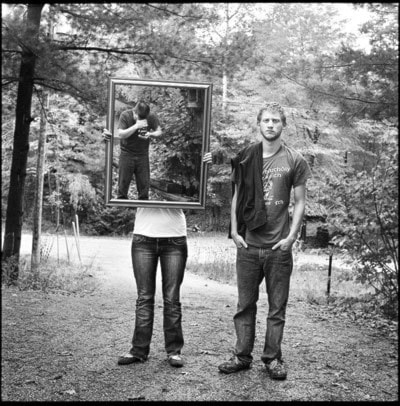‘Don’t worry, your eyes will adjust,” said Morgan Whibley, turning off the darkroom’s lights.
“And watch yourself — that’s pure selenium. That shit’ll mess you up.”
I tried not to move or touch anything and just listened to the music that filled the room — Delia’s Gone by Johnny Cash.
“The first time I shot her, I shot her in the side….”
“Ha!” came the laughing voice out of the darkness, “the first time I shot her.”
Slowly the crooked teeth of Whibley’s distinctive smile came into focus, shining crimson in the red light.
My eyes began to adjust to reveal the rest of him, looking like a butcher in a long black apron and moving deliberately between the trays of chemicals as he developed a photo.
The picture was of the folk music pseudo-stars, Dandelion Wreath.
It was Tuesday morning — only three days before Whibley’s first solo show at the Yukon Arts Centre community gallery.
“It’s the way I work,” he said, taking out another piece of photographic paper and cutting it to size.
“It has to come down to crunch time for everything else to be forced out of my head and then all I think about is chemistry and density and times….”
The show, Conversations, is a series of hand-printed black and white portraits of Yukon artists.
The only thing that’s consistent about the project is the camera that Whibley uses — a medium-format relic from 1957 — and the equally ancient printing methods.
The actual shots are as varied as the artists whom they portray, he said.
“I just go and meet these people — talk to them and hang out with them — and the shot presents itself.”
It’s the first time that Whibley has done a series of shots solely for artistic merit.
As a freelance photographer he normally does commercial or commissioned work.
“I never consider myself an artist,” he said.
“I always consider myself to be more of a tradesperson.”
It all goes back to Whibley’s father, who was also a professional photographer.
“We never hung out wearing berets, smoking cigarettes or acting like artists,” he said.
“My father always had a cigar hanging out of his mouth, a Hawaiian shirt half open and his hair all messed up.
“He looked like a retired GI on shore leave or a mix between Johnny Cash and Charlton Heston.”
Growing up in darkrooms, sorting through negatives, Whibley couldn’t help becoming a photographer himself — despite the fact that his father told him he should be a doctor or lawyer if he had any brains.
But the young photographer never realized how much he had learned from his father until he went away to Algonquin College in Ottawa to study photography seriously.
“All the stuff on aperture, shutter speeds, sensitivity of film, composition and stuff — these are things that I’ve been listening to in the background since I was a child,” said Whibley.
“You almost learn it by osmosis.”
When he was just 13 years old, Whibley’s father also gave him the aged Yashica-Mat camera that he used for the portrait series.
“It’s traveled all over the world with me, it’s been overseas, it’s been here, there and everywhere,” he said.
“It’s 51 years old and everything still works perfectly. You buy a digital camera today and you get maybe a good two years out of it and then you might as well just throw it in the garbage.
“It’s just a camera that I have a lot of attachment to.”
While he doesn’t have any problem with digital photography, Whibley enjoys the more traditional format.
“This reminds me that it takes time to create something beautiful and that you have to concentrate and work at it,” he said, dipping another piece of paper into the chemicals.
“If there was a market for this type of thing, this could support me, but we live in a world where things must be done right away, returned to you right now and at the lowest possible price.
“You get old crafts like this that slowly get consumed by the times.”
But the rich images that film produces are still superior to digital, he added.
“And people don’t feel as threatened as say if you had a 300-mm lens on a SLR, which you happen to hold like an assault rifle, and you stick it in their face.”
Because the viewfinder is located on the top of his little camera, Whibley holds it at chest level with a wide, open stance.
It makes people feel more comfortable, he said.
“Instantly it helps the portraiture because the camera itself is a conversation piece that relaxes the subject.”
The inspiration for Conversations was coming to Whitehorse over a year ago and quickly meeting many close friends throughout the arts community.
These friends include Mario Villeneuve, who is letting Whibley have free rein of the darkroom in his Takhini East home.
“This is the first run, the first set out of the darkroom,” said Whibley.
“The first round is very much the people that I met in a short period of time and the people that I really connected with.
“But I want to keep doing this as long as I’m in the Yukon.”
Whibley doesn’t want the clichéd shots of a painter painting or a musician in the studio with the headphones on and a guitar in his hand.
“I want the people,” he said.
“These are all born out of conversations I’ve had with people that I spent time with to kind of find their character.”
Conversations is hanging at the Yukon Arts Centre from June 27 to July 27.
